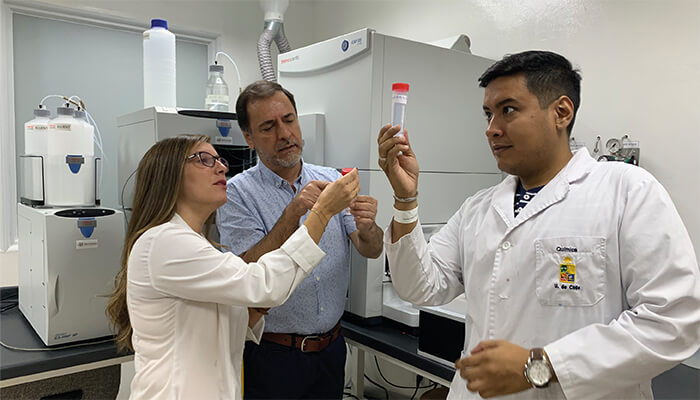We take a look at a region that has seen rapid development in the analytical sciences in recent years through the eyes of three analytical chemists working at the cutting-edge in Brazil, Chile, and Colombia.
By Pablo Richter
My research
Currently, I am focused on the development of microextraction technologies to improve sample preparation (environmental, food and biological) and its coupling with chromatography and mass spectrometry. In the last few years, we have paid special attention to emerging organic pollutants (including endocrine disrupting chemicals, EDCs), developing not only quantitative analytical methodologies, but also biomimetic strategies to determine the bioavailable fraction of a pollutant.
Our group developed rotating disk sorptive extraction (RDSE) in 2009, which has been applied to various sample types for the extraction of analytes of interest, both in liquid samples and bioavailable fractions of solid samples. RDSE is a very simple, rapid and inexpensive approach with several additional key advantages:
-
The high surface-area-to-volume ratio of the device;
- Extractions are performed from a low volume of liquid samples;
- The recirculating regime prevents the collapse of the filter in complex samples, allowing continuous contact between solid and liquid phases;
- The geometry of the device permits a high rotation velocity;
- The adsorptive phase is easily replaceable, allowing the use of either commercial, natural or laboratory-synthesized sorbents.
Now, we are continuing to work on microextraction techniques, but we are migrating towards bioanalytical applications. As I am not a biochemist, we have established a collaborative relationship with my colleague, Alfonso Paredes, to study the effect produced by some EDCs on the endocrine system, using microextraction and mass spectrometry to identify biomarkers in biological fluids. We are supervising the PhD thesis of a Venezuelan student, Daniel Arismendi, who has accepted the challenge of addressing new bioanalytical problems.
I hope in the coming years to achieve a consolidated research line in the interdisciplinary field of bioanalytics – a fascinating challenge for an analytical chemist who has mainly covered applications in more classical fields (inorganic and organic chemistry).
Analytical science in Chile
The area of analytical chemistry did not start to develop in Chile until the 1980s, with the first PhDs formed in Chile in analytical chemistry in the 1990s. As recently as 20 years ago, the position of analytical chemistry in Chile was troubling. The discipline was seen as subordinate to other areas of chemistry, with no more than four active groups dedicated to the field.

There were no analytical chemists in the evaluation panels or study groups of the main scientific and technological agency (CONICYT), making it hard for analytical chemists to access research funds. Thankfully, the tide has gradually turned. Today, analytical chemistry is recognized alongside other branches of chemistry, and is an increasingly popular choice for PhD projects.
The Chilean food industry is a substantial contributor to our economy (in particular, fresh fruit, forestry, wine and fishery products). Before export, food products must be certified safe – a process conducted by accredited public and private laboratories, using modern equipment. The laboratories must be accredited by the ISO 17025 standard and undergo regular audits by government regulators. One of my PhD students worked with such a laboratory to introduce analytical methodologies based on RDSE technology and LC-MS, to validate new veterinary pharmaceuticals for approval by the Agricultural and Livestock Service of Chile.
Looking ahead
Analytical chemistry has a clear role to play in solving important challenges facing Chilean science and society. For example, we need to find responses to environmental emergencies, such as the recent air pollution event from the Ventanas Industrial Park, at the border of the Puchuncaví and Quintero communes. Typically, government agencies are only detecting pollution after it has caused a negative effect on the population. There is a lack of coordination among the analytical scientists in the country, particularly those belonging to the academic sector. By coordinating a collective opinion, we would be better able develop solutions to pressing problems.
The biggest challenge for researchers in Chile is funding. The budget for science, technology and innovation in Chile represents only 0.38 percent of GDP (compared with 1.17 percent in Brazil and 2.74 percent in the USA) – a figure that has remained relatively static since 2011.
Funding must increase, if Chile is to achieve its goal of moving the economy away from the export of natural resources to one that develops competitive advantages through innovation. In 2018, the main science-funding program (FONDECYT) approved 38 projects out of a total of 138 submissions in chemistry, with about eight projects related to separation sciences.
Industry funding is similarly scarce. Though the government has instituted some policies to encourage industry collaborations with academics, they have been largely weighted in favor of short-term projects that benefit companies, rather than longer-term partnerships with more scientific value. Of the 18 PhD theses supervised in my lab, only three have been developed in collaboration with the commercial sector. Clearly, we need to strengthen these relationships.
Thankfully, the President appointed the first Minister of Science, Technology, Knowledge and Innovation in December 2018, and we hope that the newly created ministry will be given the resources to fulfil the expectations of the scientific community.
Where Next?
This article is the start of an ongoing series highlighting the achievements of analytical scientists in different regions, particularly areas that are under-represented at conferences, in journals – and in our own Power List. We’d love to hear where you think we should turn our spotlight next – email charlotte.barker@texerepublishing.com or leave a comment online.




